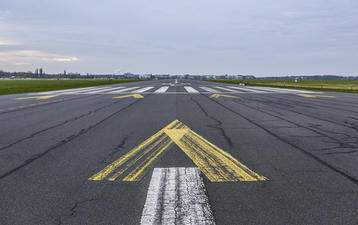Declaring Runway Distances and Displacing Thresholds
The temporary change of declared landing and take-off distances is a very important instrument for airport operations. It enables to maintain air operations during construction works or after an incident – instead of closing the runway.
Nevertheless, the displacement of thresholds is often conducted in a rush by untrained staff, possibly resulting in the non-consideration of several safety critical aspects.
The main purpose of this 2-day course is to provide to the staff involved in airport operations (incl. oversight and regulators) with the necessary knowledge of the minimum technical and operational requirements for re-declaring declared distances and displacing thresholds.
Attendees will learn about the technical and operational limitations on runway operations, the applicable obstacle clearance criteria, the infrastructural requirements (incl. markings, lighting, NAVAID) as well as the operational procedures e.g. for promulgating reduced distances and controlling hazards.
Through practical exercises, participants will be required for different scenarios to determine the threshold locations, assess the consequences on operations, calculate the available declared distances, as well as define the applicable requirements on marking and lighting.
Please note: This course can also be booked as an in-house version in German - however, the course material is only available in English.
Course Details
Location:In-houseLanguage:German / English
Duration:2 days
Provider:airsight GmbH
Course Content
Technical and operational limitations on runway operations
- Mass limitations (MTM, MTOM, MLM, MZFM, OEM)
- Relevant runway lengths and distances (TORA, TODA, ASDA, LDA)
- Operational basics for take-off, approach and landing (speeds, aircraft performance, etc.)
- Approach procedures (non-instrument and instrument: NPA, APV, PA etc.) and associated runway requirements (ICAO Annex 6, 14,10 PANS-OPS Vol. II)
Obstacles
- Relevant adjacent areas of runways (RWY strip, RESA, clearway, stopway)
- ICAO Annex 14 obstacle limitation surfaces (approach, transitional, take-off climb surfaces, obstacle free zone)
- ICAO PANS-OPS obstacle protection areas (OCA/H)
- ICAO PANS-OPS Flight procedures
- Certification performance requirements (Take Off Path, Gross & Net Take Off Flight Path)
Infrastructure
- Relevant runway markings and lighting
- Displaced threshold marking
- Displaced threshold lighting
- Visual Approach Slope Indicator Systems
- Instrument Landing System (ILS)
- Area Navigation (RNAV)
- Satellite-Based Navigation (ABAS, SBAS, GBAS)
Operational Procedures
- Management of re-declared distances
- Guidelines and Calculation of reduced distances
- Control of temporary hazards
- Promulgation
- Pre-defined scenarios
- Case studies of displaced thresholds after an accident
- Approach over obstacles
- Operation - Exercises
Trainer
Jan Walther, Dipl.-Ing.
Head of airsight’s Aerodrome Safety and Operations department, Mr Walther is an aviation consultant and project engineer for airsight with extensive expertise in airport operations, aircraft operations, apron management services, air traffic control services, ground handling as well as safety management systems for aerodromes.
Mr Walther holds a Diploma degree in transport engineering. At airsight he is leading the Aerodrome Safety and Operations involved in the conduction of several safety assessments at airports in Europe and worldwide, focusing on airport operations and air traffic control related issues as well as safety management systems. The strength of his team's work lies in working in technically and politically complex environments.
He has led the 2-years research study about the so-called Triple One concept on behalf of EASA and was involved in a research project of the Ministry of Transport for development of an initial state safety programme in Germany. Within international projects (e.g. Dubai, Dublin, Auckland, Luxembourg, Singapore, Toronto), he is the responsible project manager and controller for safety assessments, which require in-depth knowledge of air traffic control services and airport operations (e. g. implementation of staggered runway operations, implementation of Remote Tower Center).
Target Group
- Aerodrome operations managers and duty officers
- Aerodrome designers, engineers and planners
- Aerodrome safety managers
- Aerodrome quality and compliance managers
- Architects and civil engineers
- Civil Aviation Authorities staff
- Air Traffic Control staff
Organisational Details
airsight offers this training course on request, worldwide. At the end of the course, all participants will receive an airsight certificate based on EASA training regulations, which is highly recognised throughout the aviation industry.
About airsight Training
airsight Training course quality
airsight operates an ISO 9001 certified Quality Management System and pursues the objective to provide high quality services that fully meet the clients’ needs.


 Training 5 or more people? Ask for an In-house course at your premises or online!
Training 5 or more people? Ask for an In-house course at your premises or online!


